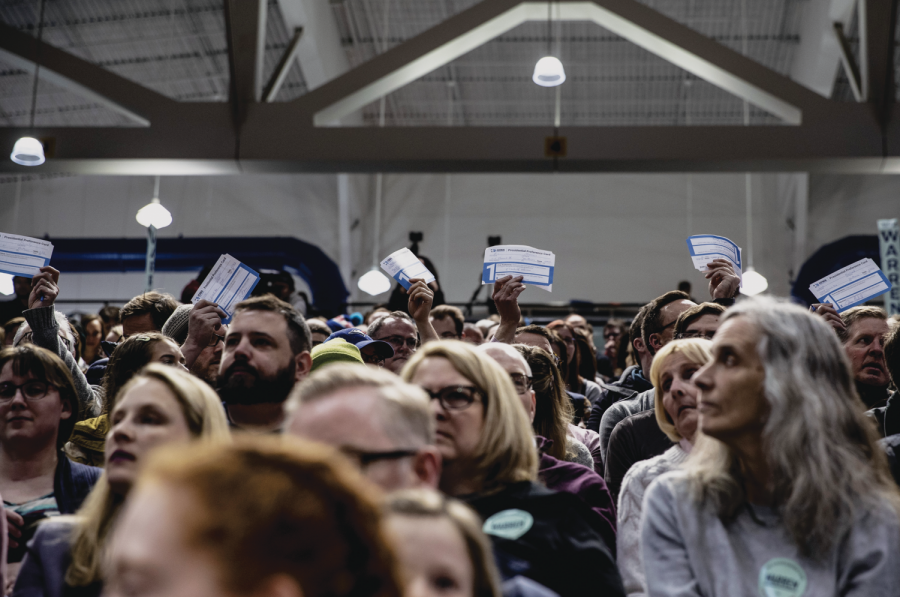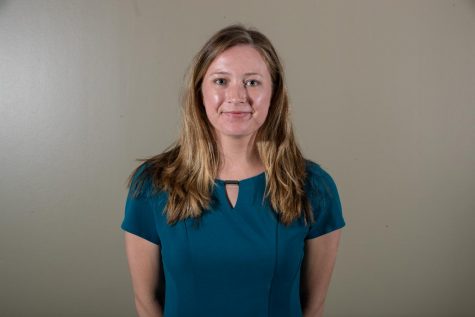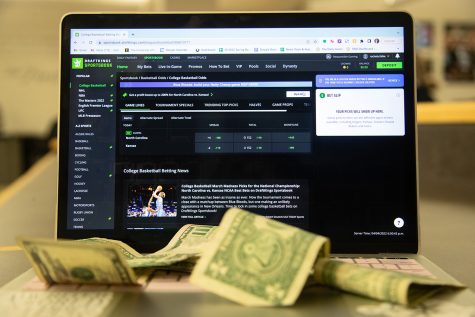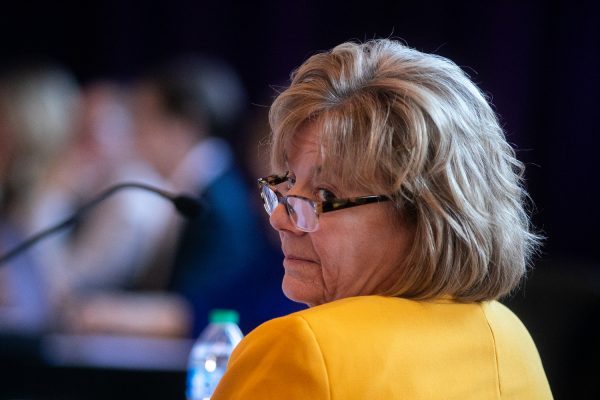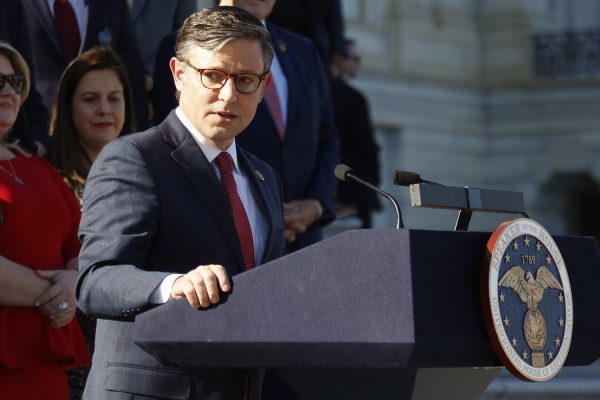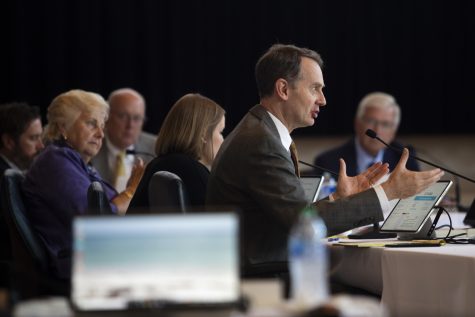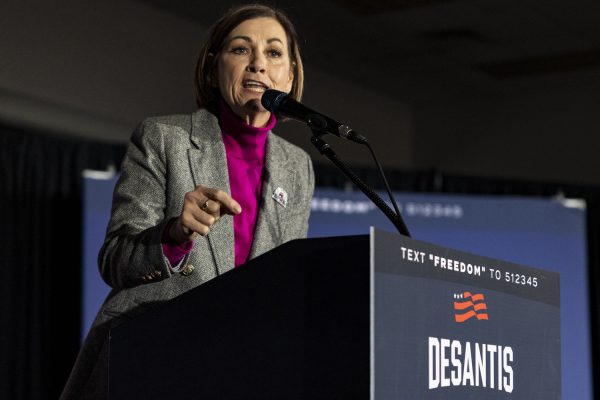How a relatively smooth Iowa caucus process derailed
The caucuses results released at 4 p.m., after candidates took off for New Hampshire and a 12-hour media hole filled with caucus process stories instead of who did well or poorly in Iowa. Here’s what we know happened.
Supporters of Sen. Elizabeth Warren, D-Mass., hold up cards during the caucus at Des Moines Precinct 62 in the Knapp Center on Monday, February 3, 2020. The caucus head count reached 849 people, leaving 127 individuals needed for the candidate to be declared viable. Sen. Warren received 212 1st round total head count votes.
February 5, 2020
After more than a year of campaigning and breathless media coverage following as many as 25 presidential hopefuls across the state, Iowa didn’t show the nation results of its first-in-the-nation nominating contest until 4 p.m. Tuesday — a full 21 hours after caucuses began. Even then, just over half — 62.7 percent — of precincts were reporting results, which showed former South Bend, Indiana Mayor Pete Buttigieg and Sen. Bernie Sanders, I-Vt., leading support in the state.
In interviews with a dozen county chairs, precinct captains, and caucusgoers, several reported their caucuses ran unprecedentedly smooth up until it was time to report results.
When some precinct captains’ apps failed to send results, the plan B for reporting final tallies to the state party — a phone line — became overloaded with calls from precinct chairs reporting results to the state party.
The delay in statewide results resulted from a series of problems that arose on caucus night, Iowa Democratic Party officials and volunteer organizers said, including a glitching new reporting app and inconsistencies between multiple reporting metrics, lengthening the manual verification process.
Now, Nevada Democratic caucus officials have said they’re striking the use of the problematic app, just three weeks ahead of their state’s caucuses.
Interactive timeline
Linn County Democratic chair Bret Nilles said he counted up the three measures of caucusgoer support at his precinct Monday night, entered in the results on the Iowa Democratic Party’s smartphone app, and hit send without a hitch.
He made it back to the Linn County Democratic Party headquarters at about 9:15 p.m., where he found out other precinct chairs in his county didn’t go through quite as smooth of a process.
Other precinct chairs brought registration papers and initial results to a centralized location where Nilles and other Linn County Democratic volunteers set up camp. Some precinct chairs had tried to download the app over the weekend or that day, but experienced troubles using it to report results.
He said there were two camps of people having trouble — those who couldn’t log in to the app, and those who weren’t sure if their results successfully sent to the Des Moines headquarters.
He said most caucuses in Linn County — home to Iowa’s second largest city, Cedar Rapids — were wrapping up before 10 p.m., but results reporting took between sometimes an hour and an hour and a half.
“I could tell something was going on because a majority of people were walking in with their phones on speaker phone, and music coming from those speaker phones,” Nilles said. “They were on hold for an hour or an hour and a half.”
Iowa City Precinct 8 Chair Janice Weiner, an Iowa City city councilor, didn’t have any problems with reporting via the app, she said. However, as a backup, she sent an emailed photo of her caucus results sheet to the Iowa Democratic Party to confirm that they’d received it. She said a Democratic Party official called around midnight to confirm that her results had made it in.
Scott County Democratic Party Vice Chair Toby Paone said he downloaded the app a few days before the caucuses, but the app wouldn’t accept his designated PIN number. When he still couldn’t access the app by 5:30 p.m. on caucus night, Paone said he called the Iowa Democratic Party, and officials told him to call in with the results after his caucus wrapped up.
By 10 p.m., amid reports the app was malfunctioning, Paone said the Scott County Democratic Chair texted him to hold off on calling the Iowa Democratic headquarters so she could turn in the results en masse in the morning.
But, he’d already called the party, and waited on hold for an hour while he cleared up his precinct site. He also took a picture of his caucus worksheet and sent it on to the Iowa Democratic Party via email.
Other than the app misreporting, Paone said any other problems at the caucus site were easily fixable.
“The app was definitely the main problem,” he said.
What’s the app?
The app was created by Shadow, Inc., a Washington-based company. Records from the Iowa Ethics and Campaign Disclosure Board show the Iowa Democratic Party paid $63,000 in two installments in November and December for the company to develop the app to report secure results for the caucuses.
According to Federal Election Commission filings, multiple presidential campaigns and Democratic groups have also paid Shadow for donation shepherding and text messaging software development.
Pete For America, the principal campaign committee for Buttigieg, paid Shadow twice for a total of $42,500 for “software rights and subscriptions.”
Biden for President paid $1,225, for text-messaging services, and Gillibrand 2020 paid six times (including twice after her campaign was suspended) for a total of $37,400. Five of those payments are marked as “software” and one as “fundraising consulting.”
We sincerely regret the delay in the reporting of the results of last night’s Iowa caucuses and the uncertainty it has caused to the candidates, their campaigns, and Democratic caucus-goers.
— Shadow, Inc. (@ShadowIncHQ) February 4, 2020
In a release Tuesday morning, Iowa Democratic Party Chair Troy Price said there was a “coding issue” within the reporting app that was causing the app to report sporadic results.
“As part of our investigation, we determined with certainty that the underlying data collected via the app was sound. While the app was recording data accurately, it was reporting out only partial data. We have determined that this was due to a coding issue in the reporting system. This issue was identified and fixed. The application’s reporting issue did not impact the ability of precinct chairs to report data accurately,” Price said.
The Iowa Democratic Party used a reporting app in 2016, but with only needing to report one metric, and an easier log-in process than the new app, Nilles said the reporting process in 2016 was much simpler than in 2020.
For the 2020 caucuses, the Iowa Democratic Party released three metrics of support instead of just one — the first alignment (the initial tally of supporters), the final alignment (the number of supporters in camps reaching 15 percent of attendees in a precinct), and the state delegate equivalents (the number of state delegates per candidate the party expects to send to the state convention).
Not only did caucus-site leaders need to report those additional metrics, but there were extra steps to log into the app as well for security purposes, Nilles said. Result reporters needed a specific email tied to their precinct so no one else could access that precinct, while previous years required just a precinct code and a PIN number.
After first insisting the delay in results was due to “inconsistencies” between reporting metrics, Iowa Democratic Party Chair Troy Price released a statement Tuesday morning that faulted a coding issue in the reporting app for the delay. He said the app was reporting accurate results, but was spitting out partial numbers of precincts, forcing the state party to verify precincts manually.
New changes expedited process for some precincts
Not everything ran poorly, however. In interviews with several county Democratic chairs and precinct captains, many said the initial caucus was run the smoothest it’s ever gone. The real trouble began after everyone left their caucus sites, when it came time to report results to state headquarters.
Woodbury County Democratic Chair Jeremy Dumkrieger said he couldn’t download the app early in the day. So, he decided early he would phone-in the results to the Iowa Democratic Party.
His caucus wrapped up by 8:30 p.m., but he waited on hold with the Democratic Party for half an hour while boxing up results.
“We’ve been hearing all day from everybody up here that this is the smoothest-run caucus we’ve ever had, and everyone’s really impressed with it. It’s just that one reporting app,” he said. “If that app would’ve worked, everybody would’ve been singing praises.”
He said additional training, bigger caucus sites, more precinct locations, and changes to how caucusgoers recorded their presidential preference helped expedite the caucus process.
Results buried in process story, but better accurate than too quick
Dumkreiger said while he thought the results of the Iowa caucuses would likely be overshadowed by the delay in reporting, he believed that reporting the results accurately the first time would actually be a bigger benefit to the party than reporting wrong results and then correcting themselves.
This isn’t the only time the Iowa caucuses have had trouble reporting results.
In 2012, the Iowa Republican Party reversed the winner of the Iowa caucuses 16 days after the caucuses. On caucus night, Republican officials called Sen. Mitt Romney, R-Utah, the winner, and later said former Sen. Rick Santorum, R-Pa., won the most support.
‘A little confusion over caucus preference cards’
New this year, the Iowa Democratic Party implemented caucus preference cards, where caucusgoers would write down their presidential preferences in order to create a paper trail if results were questioned.
The Scott County Democrats vice chair, Paone, said there was some confusion over those new preference cards, such as where people should sign their names, but overall, he said the caucus went very smoothly.
“My caucus actually went really well,” he said. “Of the nearly 294 people at my precinct, nearly 65 people switched parties or were new caucusgoers.”
In Iowa City, Deeth said some camps at the IMU weren’t fully informed of the rule changes, leading to several people to leave before the final alignment because of a lack of understanding the new rules — a problem he believes many faced across the state.
“I just saw basically all the, [former Vice President Joe] Biden people and all the [Senator from Minnesota Amy] Klobuchar people, just turn in their cards and left. They just wanted to get their vote counted for their candidate because they saw right away, they were not even close to viability, and they didn’t want to make a second choice,” Deeth said. “And that made the caucus math complicated.”



